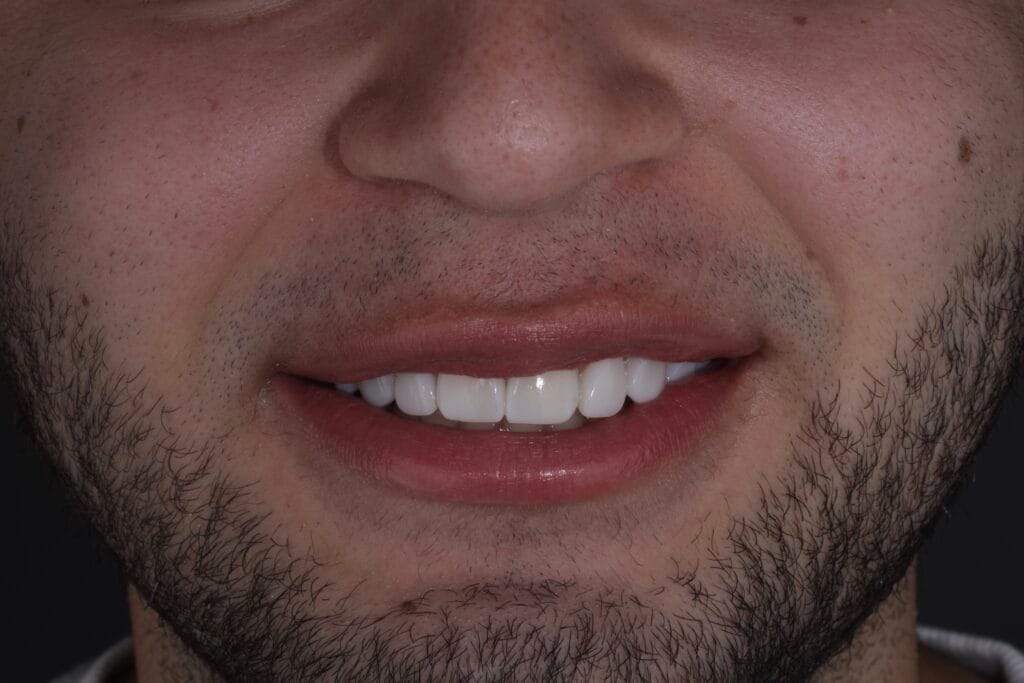

Sometimes the most impactful changes in dental aesthetics aren’t about color or shape, but about a small detail that often goes unnoticed — until it’s corrected.
This was the case for José, a young patient who came to Sonrisa Italiana seeking a smile design, mainly to enhance the shape and color of his teeth. However, there was something else that truly concerned him: his teeth barely showed when he spoke.
Although at first glance his smile seemed to be in good condition, this subtle detail significantly influenced the expressiveness of his face. When talking, his smile appeared shy, muted, as if something vital was missing to fully convey his youth and energy.

Why Is It Important for Teeth to Show While Speaking?
In modern dental aesthetics, one of the key indicators of youth and naturalness is the visibility of the upper central teeth during speech.
Studies have determined that, on average, about 3 to 4 millimeters of the upper central incisors should be visible during normal speaking.
When this exposure is absent or very limited, the face can appear more serious, muted, or even older — regardless of the person’s actual age.
It’s not just about having straight or white teeth: it’s about how the teeth interact with the lips, muscles, and facial movements.
A lively smile is one that naturally integrates with the face, both at rest and in action.
When Dental Anatomy Doesn’t Fully Support Expression
Severe tooth wear isn’t always the cause of reduced dental exposure. In cases like José’s, the original proportions of his teeth and their relationship with the lips during movement simply didn’t create the ideal dynamic.
Contemporary aesthetic dentistry recognizes that not every case involves repairing damage — sometimes it’s about optimizing what is already healthy, enhancing the balance between form, function, and expression.



José’s Treatment: Restoring His Stage Presence
José wasn’t just looking to improve his smile; as a musician, his stage presence greatly depended on his facial expression. His face needed to complement his energy during performances, projecting confidence, freshness, and authenticity.
The case was led by Dr. Daniel Zabaleta Díaz, who proposed a treatment specifically focused on restoring ideal dental exposure.
The plan included:
- 10 direct composite veneers, carefully layered to increase the length of the teeth, refine their shape and color, and naturally reestablish the relationship between smile and movement.



Every detail of the design was crafted to preserve functionality, ensuring José could express himself freely on stage, without affecting his speech, chewing, or comfort.
A Treatment That Transformed His Presence
Today, thanks to the work done, José’s stage presence comes alive. His smile now harmonizes naturally with his expression, strengthening the visual and emotional connection that is so crucial for any artist.
The transformation was not minor: enhancing the length and visibility of his teeth completely changed the dynamics of his face in motion, boosting his confidence, freshness, and authenticity on stage.

At Sonrisa Italiana, we believe that aesthetic dentistry isn’t about changing who you are — it’s about restoring the natural harmony that sometimes gets lost or was never fully expressed.
Seemingly subtle details, like proper dental visibility while speaking, can have a profound impact on how we express ourselves — and how the world sees us.


Case review written by Dr. Laura Bula, expert in dental and facial aesthetics


